Tableware and Dining Accessories
How Should Tableware Be Stored in a Restaurant
Curate a safe and hygienic environment by implementing proper tableware storage practices in restaurants.
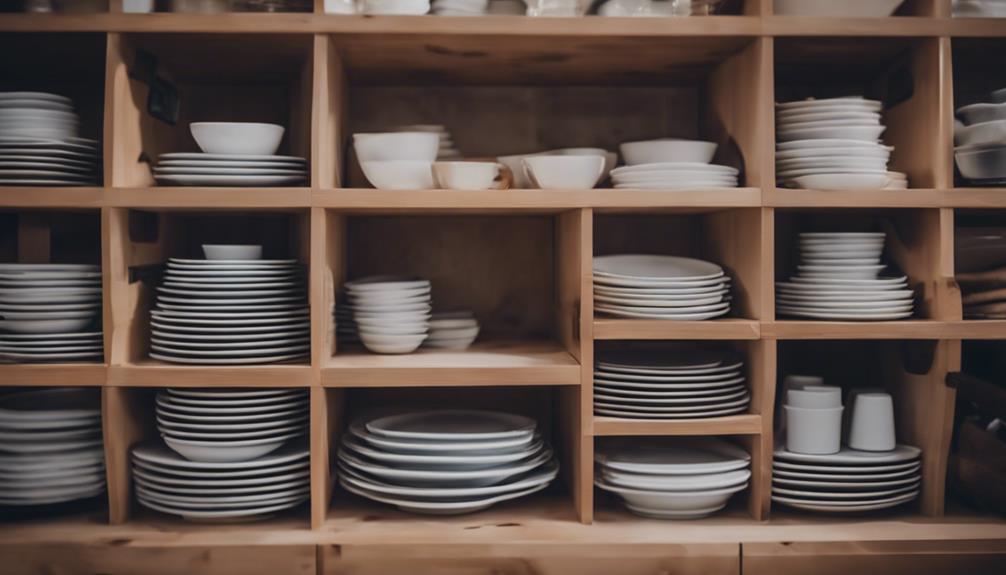
To store tableware in a restaurant, keep utensils in clean, dry areas to prevent contamination. Use proper cleaning methods and sanitize regularly. Efficiently wash and dry utensils with commercial equipment like dishwashers and racks. Avoid bacterial growth by ensuring thorough drying before storing. Utilize self-draining positions and upside-down storage to maintain hygiene and prevent damage. Opt for well-ventilated storage areas to reduce moisture and odors. Invest in quality storage solutions like stackable racks and drawer dividers for efficient organization. Enhance cleanliness, efficiency, and food safety by following these storage practices. For more insights on effective tableware storage, explore further details in the provided research.
Key Takeaways
- Store tableware in clean, dry areas to prevent contamination and maintain food safety standards.
- Utilize efficient dishwashing techniques and proper drying methods for sanitized tableware.
- Implement self-draining positions and upside-down storage to prevent bacterial growth and maintain hygiene.
- Ensure well-ventilated storage areas to reduce moisture, minimize odors, and aid in thorough drying.
- Invest in quality storage solutions like shelving options and organizational tools for better organization and efficiency.
Importance of Proper Tableware Storage
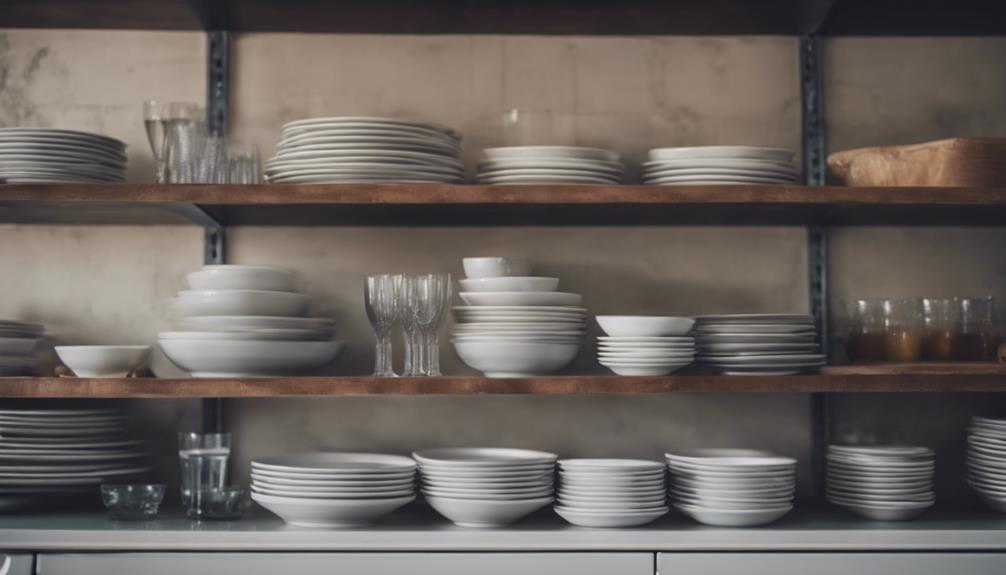
Properly storing tableware in a restaurant is essential for maintaining food safety and preventing cross-contamination. By following correct storage practices, you can greatly reduce the risk of foodborne illnesses and guarantee a safe dining experience for your customers. When tableware is stored in an organized manner, it not only enhances kitchen efficiency but also improves the overall workflow of your restaurant.
Preventing cross-contamination is vital in a food service establishment, and one way to achieve this is by storing tableware properly. By keeping different types of tableware separated and making sure they're clean and dry before storage, you can maintain high standards of food safety and hygiene. This attention to detail also helps in preventing injuries that could occur if tableware isn't stored correctly. Remember, a safe environment starts with how you handle your tableware.
Cleanliness and Food Safety Measures
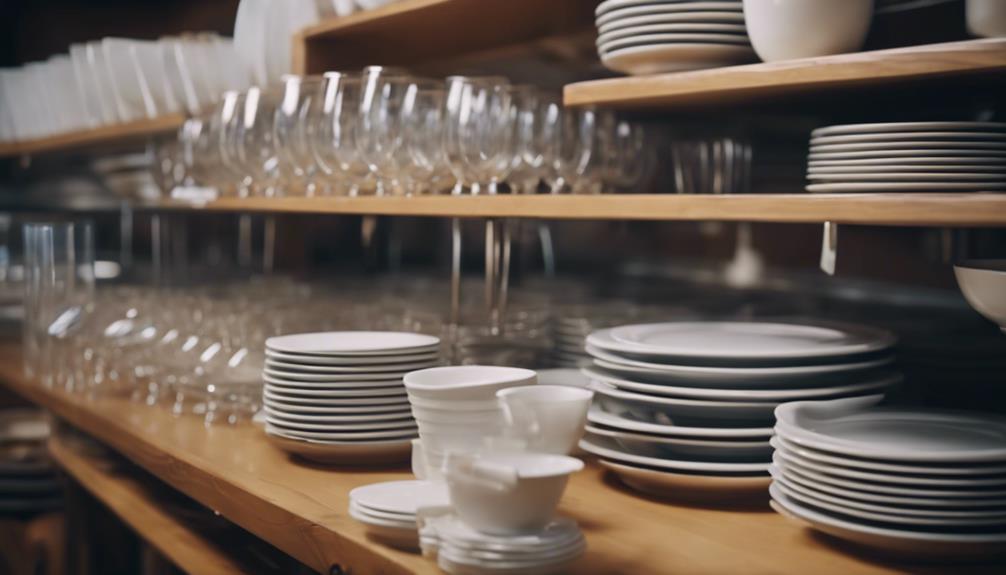
Maintaining cleanliness and implementing proper food safety measures are vital aspects of storing tableware in a restaurant. It is crucial to ensure that utensils are stored in a clean and dry environment to prevent contamination. Proper cleaning and sanitization of tableware are essential to uphold food safety standards and prevent the spread of harmful bacteria. Avoid storing utensils directly in sanitizer or ice water, as this can promote bacterial growth, compromising food safety. Regularly inspect utensils for any damage and always make sure they are completely dry before using them to serve food. By implementing efficient kitchen organization practices, you can significantly reduce the risk of cross-contamination and uphold high food safety standards within your restaurant.
| Cleanliness and Food Safety Measures | |
|---|---|
| Utensils stored in clean, dry area | Prevents contamination |
| Proper cleaning and sanitization | Maintains food safety standards |
| Avoid storing in sanitizer or ice water | Prevents bacterial growth |
Efficient Dishwashing and Drying Techniques
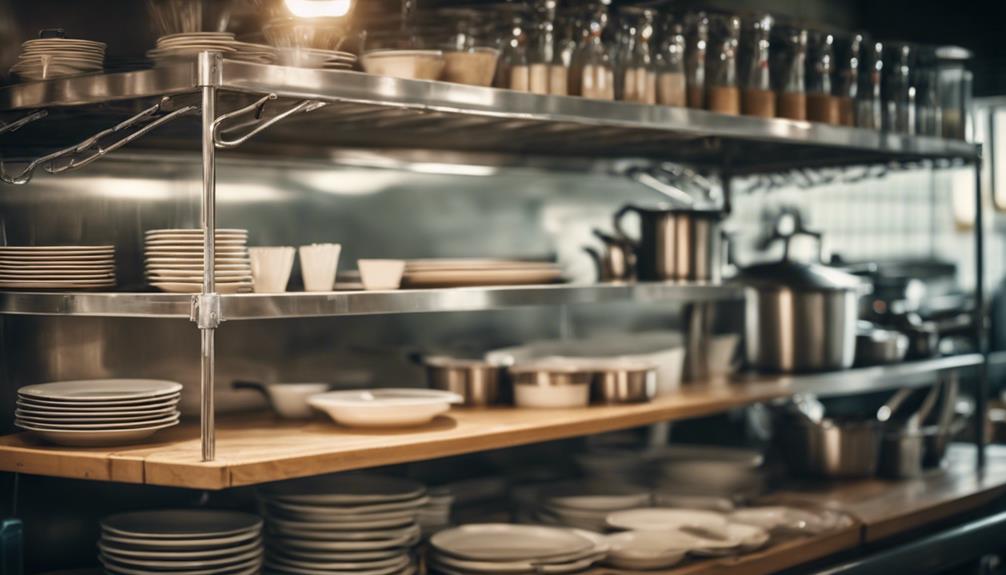
To efficiently wash and dry tableware in a restaurant, opt for speedy drying methods like air drying or using a commercial drying rack.
Implement time-saving tips such as utilizing a commercial dishwasher with proper racks and a thorough pre-rinse unit to remove food residue efficiently.
Remember to organize and store cleaned tableware in dish racks for easy access and drying to streamline your dishwashing process.
Speedy Drying Methods
For quick and effective drying of tableware in a restaurant setting, consider implementing high-temperature dishwashers for rapid sanitization and drying. These dishwashers not only guarantee utensils are sanitized efficiently but also make sure they dry quickly due to the high temperatures used during the process.
Additionally, using a commercial dish drying rack with proper ventilation can expedite the drying process by allowing air to circulate around the tableware. To further speed up drying, utilize a drying agent in the dishwasher to enhance water drainage.
Opting for air drying in a designated area with good air circulation is another effective method to quickly dry tableware. For even swifter drying, investing in a commercial heat lamp or heat-assisted drying cabinet can be beneficial.
Dishwashing Time-Saving Tips
To maximize efficiency in your restaurant's dishwashing process, implement time-saving tips and techniques that streamline both washing and drying operations. Here are some practical suggestions for ware washing and drying:
- Use pre-rinse units and rubber scrapers to save time on cleaning dried food debris.
- Load similar items together in the dishwasher for efficient washing.
- Stack plates 12 to 16 high to maximize space and save time during dishwashing.
- Invest in proper racks and shelving units to streamline the dishwashing process.
Preventing Bacterial Growth in Storage
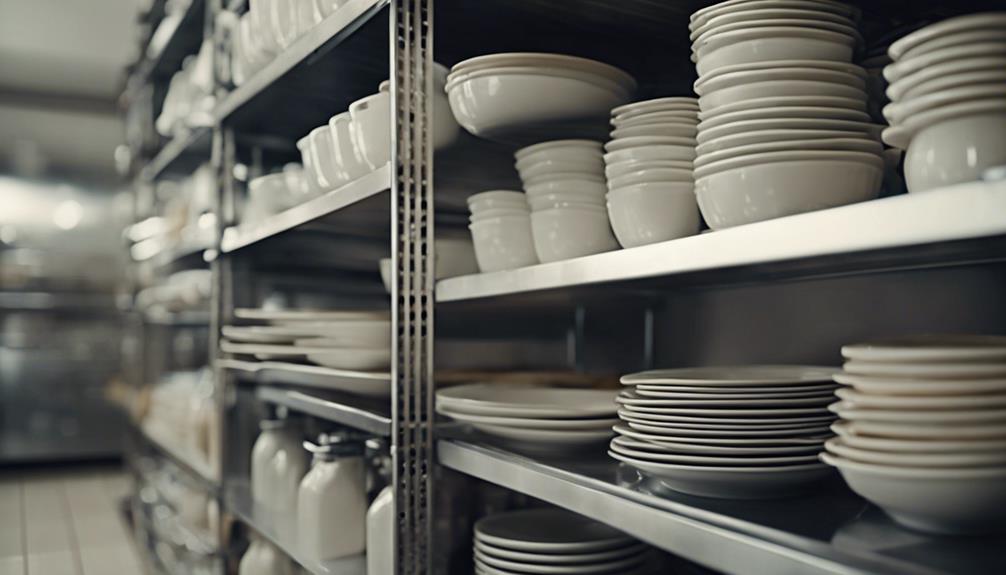
Prevent bacterial growth in storage by maintaining cleanliness and ensuring tableware is thoroughly dried before storing. Clean and sanitize storage areas regularly to eliminate any potential breeding grounds for bacteria. It's essential to store in-use utensils properly to prevent contamination.
Bacteria thrive in damp and dirty environments, emphasizing the importance of keeping storage areas dry and free from food residue. By implementing a strict cleaning and sanitizing schedule, you can uphold food safety standards and protect your customers from foodborne illnesses.
Proper storage not only prevents bacterial proliferation but also helps you avoid health code violations. Remember, a proactive approach to cleanliness in your storage practices is key to ensuring the well-being of your customers and maintaining a positive reputation for your restaurant.
Utilizing Self-Draining Positions
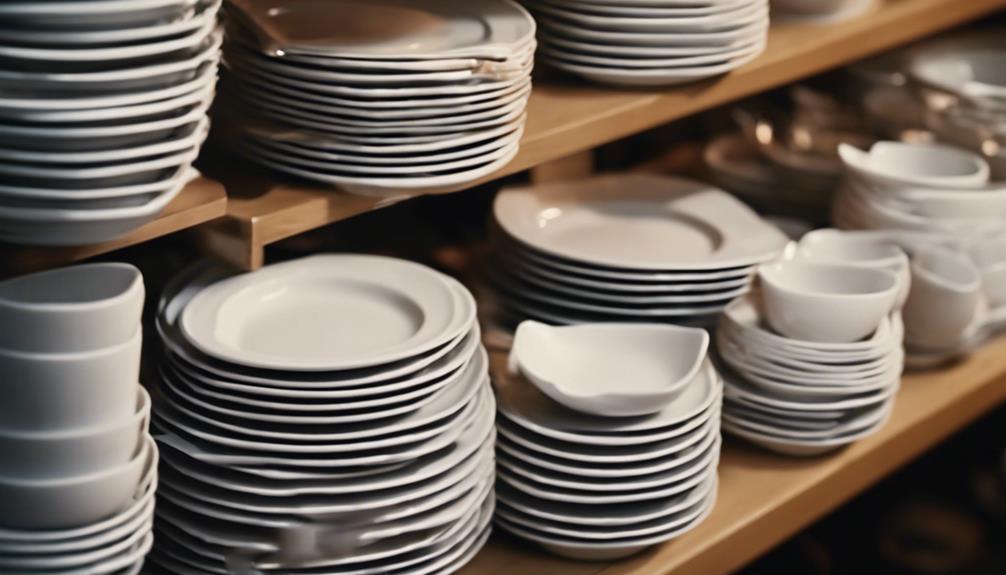
When storing tableware in a restaurant, utilizing self-draining positions is essential. This method helps prevent water buildup, reducing the risk of bacterial growth.
Ensuring proper drainage for clean storage is vital for maintaining hygiene in your kitchen.
Drainage for Clean Storage
By guaranteeing tableware is stored in self-draining positions, you contribute greatly to maintaining a hygienic environment in your restaurant. Here are some key points to take into account:
- Preventing Water Buildup: Self-draining positions help prevent pooling water, reducing the risk of bacterial growth.
- Efficient Drying: Proper drainage ensures that tableware dries efficiently, promoting hygiene.
- Contamination Reduction: Utilizing self-draining positions decreases the chance of contamination on stored tableware.
- Bacteria Prevention: Tableware stored in self-draining positions is less likely to harbor harmful bacteria.
Implementing these practices not only maintains cleanliness but also enhances overall food safety standards within your establishment.
Preventing Water Buildup
To maintain a hygienic environment in your restaurant, make sure tableware is stored in self-draining positions to prevent water buildup and promote efficient drying.
Utilizing self-draining positions helps excess water to drip off the tableware, leading to faster drying times. This practice is essential in preventing bacterial growth and maintaining food safety practices.
By avoiding water buildup, you guarantee the cleanliness and hygiene of your stored tableware. Proper drainage reduces the risk of contamination, ensuring that your tableware is always ready for immediate use.
Implementing self-draining positions may seem simple, but it's an effective way to enhance food safety practices in your restaurant's storage areas.
Inspecting for Damage Before Storage
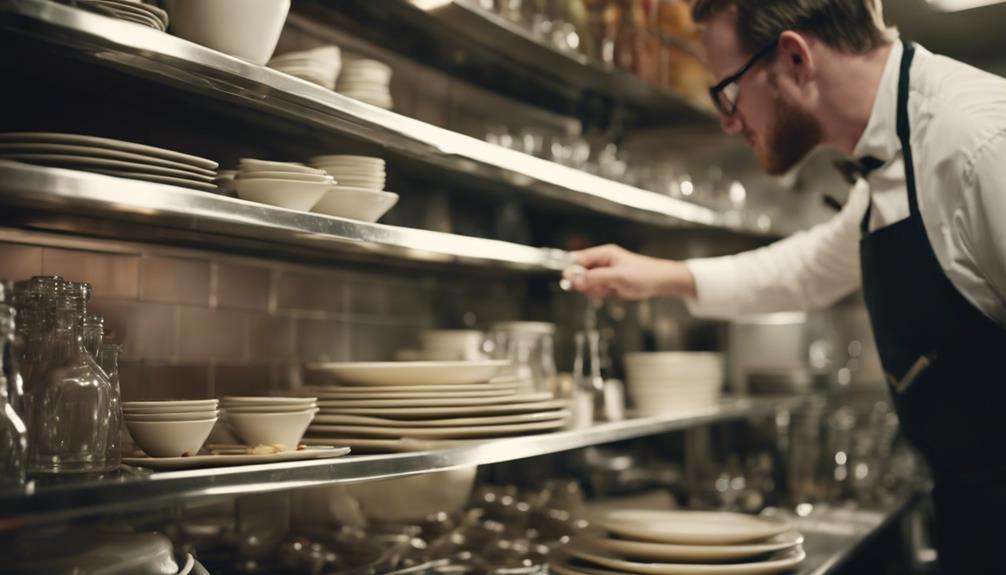
Before storing tableware in a restaurant, it's crucial to inspect for any damage such as chips, cracks, or scratches to prevent contamination. Here are four key points to ponder when examining tableware for damage:
- Check for Cracks and Chips: Inspect all tableware for any visible cracks, chips, or scratches that could harbor bacteria, ensuring proper hygiene.
- Examine Utensil Handles: Look closely at utensil handles for any signs of damage like cracks or rough edges that may compromise food safety.
- Inspect Metal Tableware: Watch out for discoloration or rust on metal tableware, as these may indicate corrosion that can contaminate food.
- Check Glassware for Sharp Edges: Ensure glassware is free from chips or sharp edges that could cause injuries to staff or customers.
Regularly evaluating and maintaining tableware helps uphold a high standard of cleanliness and safety in the restaurant.
Upside-Down Storage Method

Implementing the upside-down storage method for tableware in your restaurant can greatly enhance cleanliness and prevent damage. Storing tableware upside-down helps to keep the eating surfaces clean and free from dust and debris.
This method also protects the rims and edges of plates, reducing the risk of chipping and damage. By allowing for better air circulation, upside-down storage aids in the drying process after the tableware has been cleaned and sanitized.
It's a common practice in restaurants to store cups and glasses upside-down to maintain their cleanliness and readiness for use. By adopting this storage method, you can contribute to preventing the risk of cross-contamination and maintaining the overall hygiene of your tableware.
Consider incorporating the upside-down storage technique in your restaurant to make sure that your tableware remains in top condition for your customers.
Well-Ventilated Storage Areas
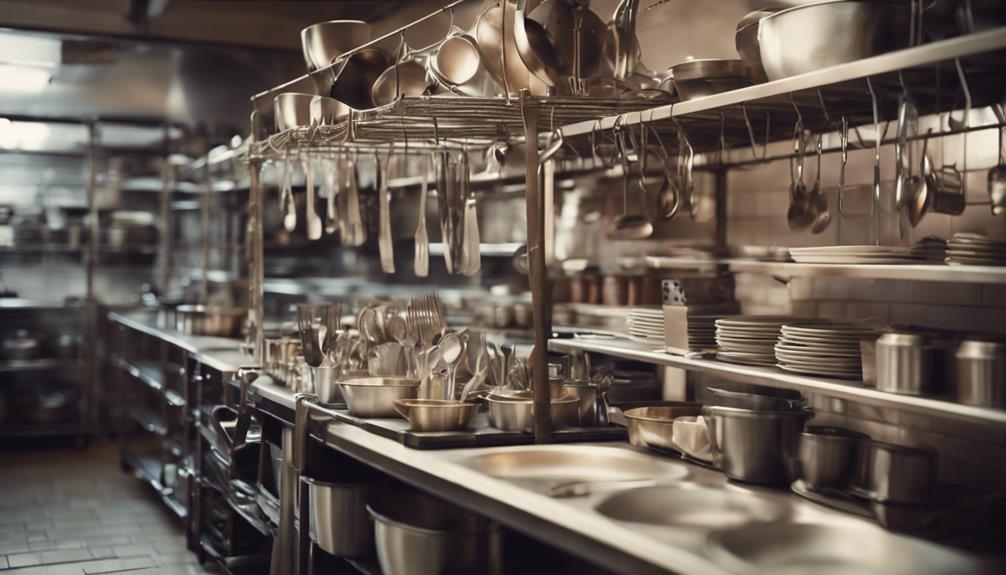
Considering the importance of maintaining cleanliness and preventing damage to your tableware, ensuring well-ventilated storage areas is essential. Here are some reasons why well-ventilated storage areas are vital for your restaurant's tableware:
- Prevents Moisture Build-Up: Adequate ventilation helps in keeping your tableware clean and dry, reducing the risk of damage from moisture.
- Reduces Bacterial Growth: Proper airflow minimizes the growth of bacteria on stored tableware, promoting hygiene and food safety.
- Minimizes Odors: Good air circulation in storage areas helps in keeping your tableware fresh and odor-free.
- Aids in Drying: Well-ventilated spaces allow your tableware to dry thoroughly between uses, ensuring they're ready for service without any leftover moisture that could attract bacteria.
Quality Storage Solutions
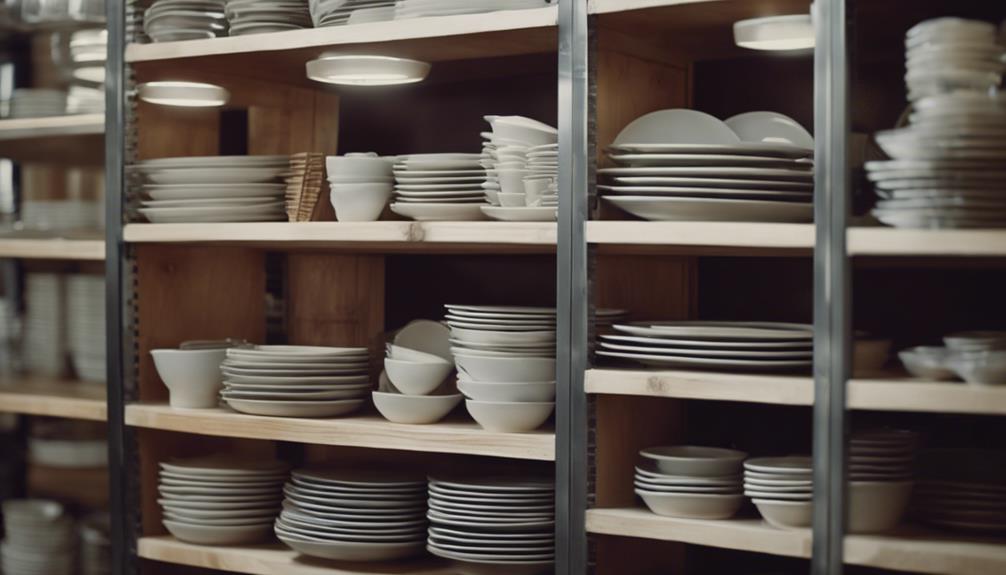
Invest in efficient shelving options, like stackable racks or adjustable shelves, to maximize space and neatly store tableware. Utilize organizational tools, such as drawer dividers or compartment trays, for utensils like forks, spoons, and knives.
Implement space-saving rack systems for glasses, plates, and bowls to streamline storage and retrieval processes in your restaurant.
Efficient Shelving Options
When outfitting your restaurant's kitchen for best organization and efficiency, exploring efficient shelving options is essential.
Here are some alternatives to explore:
- Wall-Mounted Shelves: Maximize space and keep tableware clean, ideal for easy access during food prep and service.
- Wire Shelving Units: Durable, easy to clean, and promote air circulation to prevent moisture buildup.
- Adjustable Shelving Systems: Offer flexibility to accommodate different tableware sizes, optimizing storage space for a clean and organized kitchen.
- Contribution to Efficiency: Quality storage solutions like these enhance the kitchen's organization, promoting cleanliness and efficiency in a restaurant setting.
Organizational Tools for Utensils
For better organization of utensils in your restaurant, explore quality storage solutions that enhance efficiency and cleanliness. Efficient shelving units can help maximize space and keep your tableware neatly arranged.
Consider using color-coded systems for your utensils to easily differentiate between different types, making identification a breeze during busy shifts. Implementing these color-coded systems can streamline your workflow and reduce the time spent searching for specific utensils.
Space-Saving Rack Systems
Consider implementing space-saving rack systems to efficiently store your restaurant's tableware while maximizing storage capacity and ensuring easy accessibility. These storage solutions are designed to optimize space in restaurant kitchens and dining areas.
Here are four benefits of utilizing space-saving rack systems:
- Maximize Storage Capacity: These rack systems are designed to make the most of the available space, allowing you to store a larger quantity of tableware in a compact area.
- Organize Tableware: Keep your tableware neatly organized and easily accessible, saving time and effort during busy service hours.
- Variety of Configurations: Space-saving rack systems come in various configurations to accommodate different types of tableware, ensuring a customized storage solution.
- Improved Workflow: Investing in quality storage solutions can enhance the efficiency of your restaurant's operations by streamlining the process of accessing and storing tableware.
Organizing Tableware Effectively
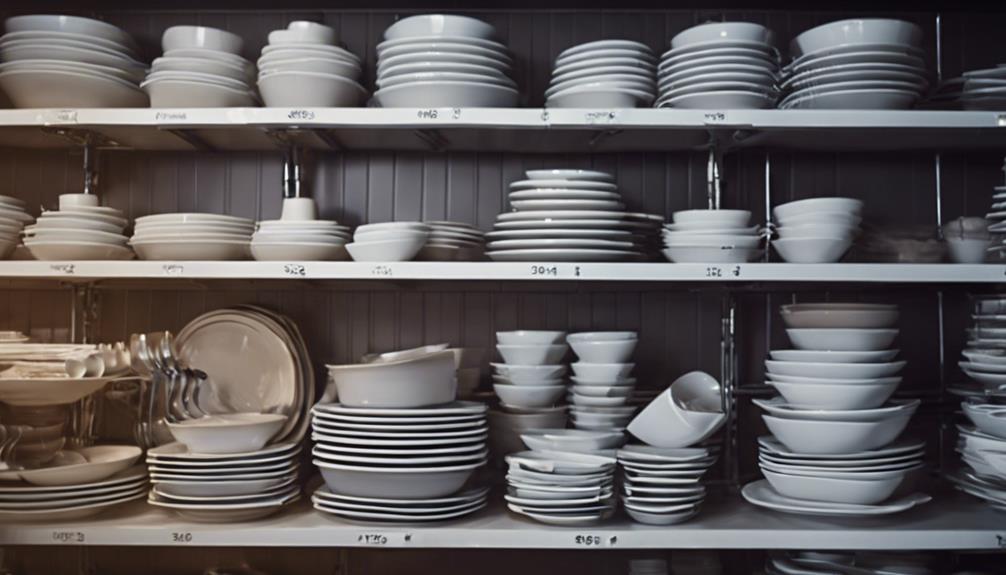
To organize tableware effectively in a restaurant, designate specific areas for plates, cups, and utensils to guarantee smooth access and efficient service. By creating designated spaces for each type of tableware, you can streamline your operations and make sure that your staff can quickly locate what they need during busy service hours. Consider implementing the following organization system:
| Tableware Type | Designated Area | Benefits |
|---|---|---|
| Plates | Shelves | Prevent breakage and facilitate stacking |
| Cups | Cabinets | Keep clean and prevent scratches |
| Utensils | Drawers or Bins | Easy access and hold utensils securely |
Frequently Asked Questions
How to Properly Store Utensils in a Restaurant?
To properly store utensils in a restaurant, make sure they're clean, dry, and stored in designated areas. After each use, clean and sanitize the utensils to maintain food safety.
For constant-use utensils, store them in a refrigerator at 41°F or less or in hot water at 135°F or more. Avoid storing utensils directly in sanitizer or ice water to prevent bacterial growth.
Organized storage practices enhance kitchen efficiency and reduce foodborne illness risks.
What Are Guidelines for Storing Tableware and Equipment?
When storing tableware and equipment, always stack plates and use cup racks to save space and prevent breakage. Utilize proper shelving near serving areas for easy access.
Keep a clean environment by removing cracked or chipped dinnerware. Prevent damage by avoiding extreme temperature changes. Stack plates 12-16 high to prevent accidents.
Following these guidelines guarantees efficient storage and maintenance of tableware in a restaurant setting.
How Should Utensils Be Stored for Food Safety?
When storing utensils for food safety, keep them clean, dry, and inspect for damage regularly. Store frequently used utensils in a refrigerated unit or hot water to prevent contamination.
Avoid storing in sanitizer or ice water to prevent bacterial growth. Make sure utensils are completely dry before use to avoid moisture-related issues.
Proper cleaning and sanitization are essential for maintaining a safe dining environment.
What Are the Rules to Observe When Storing Cutlery?
When storing cutlery, keep it clean and dry to prevent contamination. Always clean and sanitize utensils before storage for hygiene.
Avoid storing in sanitizer or ice water to prevent bacterial growth. Use color-coding or labels for organization.
Check for damage to prevent contamination. Follow these rules for safe cutlery storage in a restaurant.
Conclusion
To sum up, storing tableware properly in a restaurant is crucial for maintaining cleanliness, food safety, and efficiency. Remember the old adage, 'A place for everything, and everything in its place.'
By following proper dishwashing and drying techniques, preventing bacterial growth, and utilizing quality storage solutions, you can guarantee that your tableware is always ready for use.
Organize your tableware effectively to create a smooth dining experience for your customers.
Tableware and Dining Accessories
Which of the Following Is Not Classified as Tableware
Perplexed about what's not considered tableware? The answer starts with the letter 'P' – keep reading to uncover this intriguing distinction.

When considering items classified as tableware, it is important to note that linens, like tablecloths and napkins, are not considered tableware. Tableware typically includes chinaware, serveware, dinnerware, silverware, and drinkware, all of which facilitate serving and consuming food. These items, made from materials like ceramic and porcelain, enhance dining experiences with their size, shape, and design. Understanding this distinction can help you set the right tone and atmosphere for your meals. If you want to explore further distinctions and the importance of tableware in dining, keep uncovering more details about this essential part of meal presentation.
Key Takeaways
- Table linens like tablecloths and napkins are not classified as tableware.
- Decorative and protective items for the table.
- Tableware includes items like plates, cutlery, and glasses.
- Tableware serves functional purposes in dining.
- Table linens add style and color to the table setting.
Definition of Tableware

Tableware encompasses a range of items essential for setting the table and dining experience. These items are used for serving and come in different categories.
One of the categories of tableware is known as Chinaware. Chinaware consists of plates, bowls, teacups, and other dishes made from porcelain or bone china. It's prized for its delicate appearance and durability, making it a popular choice for special occasions and formal dining.
In addition to Chinaware, tableware includes serveware, which consists of items used for serving food at the table. This category may include platters, serving bowls, and trays designed to make serving meals easier and more elegant.
Dinnerware is another essential category, used for serving individual portions during a meal. This can include plates, bowls, and even ramekins for sauces or condiments.
Lastly, silverware comprises cutlery items like spoons, forks, and knives, while drinkware includes items like glasses, mugs, and cups for enjoying beverages. Each category plays an important role in enhancing the dining experience.
Types of Tableware Items

Chinaware, serveware, dinnerware, silverware, and drinkware are all types of tableware items that play specific roles in the dining experience.
- Serving Spoons: Essential for serving dishes like salads, casseroles, and desserts, serving spoons come in various sizes and designs to complement different serving bowls and platters.
- Soup Pots: These specialized pots are perfect for serving soups and stews, keeping them warm throughout the meal, and often feature convenient handles and lids for easy handling and storage.
- Salad Bowls: Ideal for presenting fresh salads, fruit mixes, or pasta salads, salad bowls come in different materials like glass, ceramic, or wood, adding a touch of elegance to your table setting.
Each type of tableware item serves a distinct purpose, enhancing the dining experience by not only providing functionality but also contributing to the overall aesthetic appeal of the meal.
From serving spoons to soup pots and salad bowls, these essential tableware items cater to various culinary needs and presentation styles.
Characteristics of Tableware

Tableware comes in various types, each serving a specific purpose at the dining table. The materials used in tableware can range from porcelain to stainless steel, adding to the aesthetic and durability of the items.
Functional aspects like size, shape, and design play an important role in how tableware enhances the overall dining experience.
Types of Tableware
What makes certain items essential for enhancing your dining experience? Here are three key types of tableware to take into account:
- Plates: Plates are essential for serving and presenting food in an organized and aesthetically pleasing manner. They come in various shapes, sizes, and designs to suit different dining preferences.
- Forks and Knives: Cutlery, including forks and knives, are vital tools for enjoying a meal. They facilitate the process of cutting, spearing, and conveying food to your mouth efficiently.
- Serving Bowls: Serving bowls are ideal for sharing dishes like salads, pasta, or sides with your dining companions. They add a communal aspect to the dining experience, encouraging interaction and conviviality among guests.
Materials Used
Ceramic, glass, earthenware, porcelain, and stoneware are some of the materials commonly used in tableware, each with unique characteristics that contribute to the dining experience.
Ceramic plates are known for their durability and ability to retain heat, keeping your food warm for longer periods.
Glassware adds an elegant touch to the table setting with its transparent and sophisticated appearance, perfect for formal occasions.
Earthenware brings a rustic and artisanal feel, ideal for serving food in a cozy and traditional setting.
Porcelain plates are delicate and refined, prized for their translucency and elegant look, making them a popular choice for special gatherings.
Stoneware is chip-resistant and versatile, suitable for everyday use, ensuring your tableware lasts through many meals.
Functional Aspects
When thinking about the functional aspects of tableware, it's vital to focus on how these items enhance your dining experience through usability and practicality. Here are three key points to keep in mind:
- Basic Plate: The basic plate is a fundamental piece of tableware that serves as the foundation for serving food. It should be sturdy and of an adequate size to accommodate various dishes.
- Size and Shape: The size and shape of tableware play an important role in how you present food. Different shapes and sizes can enhance the visual appeal of your meals and contribute to an enjoyable dining experience.
- Present Food: Tableware should be designed to present food in an appealing and organized manner, making it easier for you and your guests to enjoy the meal.
Importance of Tableware in Dining
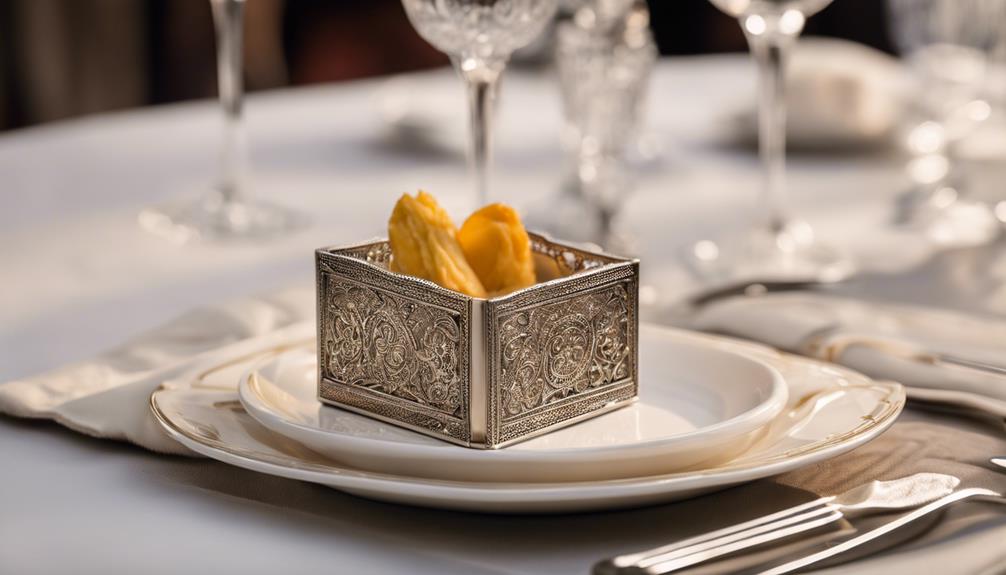
Enhance your dining experience by recognizing the vital role tableware plays in setting the tone and atmosphere of your meal. Plates, serving dishes, and utensils come in different shapes and sizes, each serving a specific purpose in the dining experience. The presentation of food on beautifully crafted plates adds style and elegance to your meals, creating a visually appealing setting that enhances your overall enjoyment.
Choosing the right tableware allows you to reflect your personal taste and preferences, showcasing your unique style to guests. The variety of tableware options available enables you to create a cohesive look for your table, completing the dining setting with sophistication. Whether it's a formal dinner or a casual brunch, the selection of tableware can greatly impact the ambiance and overall dining experience, making it essential to bear in mind the occasion when selecting your tableware. By paying attention to these details, you can elevate your dining experience and impress your guests with a well-thought-out presentation.
Distinction Between Tableware and Table Linens
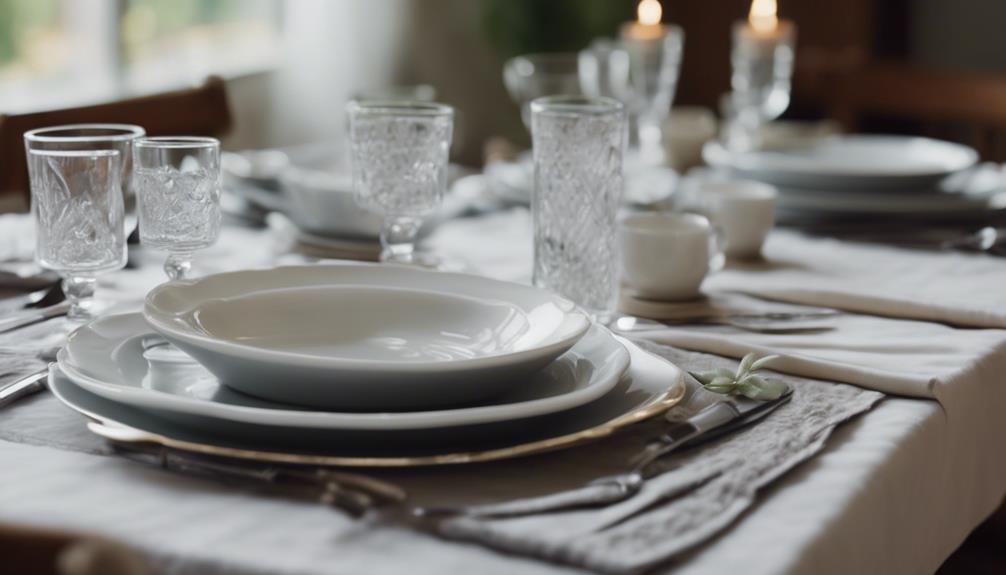
Tableware serves a practical function, facilitating the serving and consumption of food, while table linens are more about decoration and protection.
Tableware, such as plates and utensils, is essential for dining, whereas table linens like tablecloths and napkins add style and color to the dining table.
The distinction between tableware and table linens lies in their purposes – one is functional, while the other is primarily decorative.
Tableware Vs Linens
In the domain of dining aesthetics, the distinction between tableware and table linens is essential for creating a well-appointed table setting. Here are three key differences to help you understand their roles:
- Tableware: This category includes essential items like plates, glasses, and silverware used for serving and enjoying food.
- Table Linens: On the other hand, table linens such as tablecloths, napkins, and placemats serve both decorative and functional purposes in enhancing the dining experience.
- Materials: Tableware is commonly made of ceramic, glass, and stainless steel, while table linens are typically crafted from fabric like cotton, linen, or polyester.
Understanding the distinction between these two elements can elevate your table settings to new levels of sophistication and style.
Purposeful Differences
Moving from the distinction between tableware and table linens, it is important to recognize the purposeful differences that each element brings to a well-appointed dining setting. Below is a comparison table highlighting the key variances between tableware and table linens:
| Aspect | Tableware | Table Linens |
|---|---|---|
| Composition | Plates, bowls, utensils | Cloths, napkins, placemats |
| Function | Essential for serving and eating food | Protecting the table surface, enhancing dining experience |
| Material | Ceramic, glass, stainless steel | Cotton, linen, polyester |
Tableware serves the primary function of food service and consumption, while table linens focus on adding elegance, spill absorption, and protecting the table surface.
Functional Vs Decorative
For a well-appointed dining setting, distinguishing between tableware and table linens is important to understand the functional versus decorative roles each element plays.
3 Key Points:
- Table linens, such as tablecloths, placemats, and napkins, serve as decorative elements for the table setting.
- Tableware, including serveware, dinnerware, flatware, and drinkware, focuses on functional items like plates, utensils, and glasses.
- Table linens play an essential role in enhancing the visual presentation of a table setting, while tableware is crucial for serving and eating food.
Understanding the distinction between tableware and table linens is key to creating a harmonious and visually appealing dining experience.
Common Materials Used for Tableware
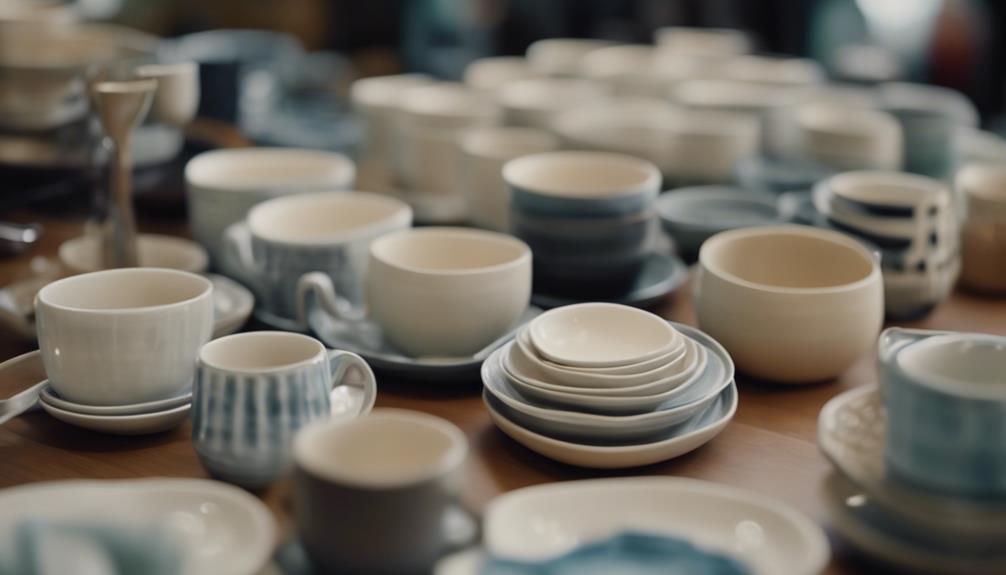
When selecting tableware, consider the common materials like ceramic, glass, earthenware, porcelain, and stoneware for their unique qualities and aesthetics. Ceramic plates are popular for their durability and versatility, making them suitable for everyday use.
Glassware adds elegance to your table setting with its transparent beauty, perfect for special occasions.
Earthenware brings a touch of tradition to your dining experience, known for its rustic and earthy appearance that adds warmth to any meal.
Porcelain is a delicate and refined material, favored for its high quality and sophisticated look on the dining table, ideal for formal settings.
Stoneware is a practical choice, offering durability and resistance to chipping, making it a reliable option for both daily meals and gatherings.
Each material has its own charm and benefits, so choose the one that best fits your style and usage preferences.
Proper Care and Maintenance of Tableware

To guarantee your tableware remains in top condition, prioritize proper care and maintenance practices. Here are three essential tips to help you keep your tableware looking its best:
- Hand wash delicate items: Instead of using a dishwasher, opt for hand washing delicate pieces like drinkware or glassware to prevent damage and preserve their quality over time.
- Avoid harsh chemicals: When cleaning your tableware, steer clear of harsh chemicals and abrasive materials that could harm the surface and appearance of your plates and glassware.
- Store carefully: To prevent chipping or breakage, store your tableware with care. Use separators or padding to cushion delicate items like your favorite steak knife and inspect them regularly for any signs of wear or damage. By addressing issues promptly, you can prolong the lifespan of your tableware and enjoy it for years to come.
Frequently Asked Questions
What Are the 4 Classification of Tableware?
The four main classifications of tableware are:
- Serveware, which includes items like serving bowls and platters.
- Dinnerware, consisting of plates and bowls.
- Silverware, comprising cutlery like spoons, forks, and knives.
- Drinkware, including glasses, mugs, and cups for drinking.
These categories cover a wide range of items used for serving and enjoying meals.
What Is Tableware and Examples?
Tableware consists of serveware, dinnerware, silverware, and drinkware. Serveware items include serving bowls and platters.
Dinnerware encompasses plates, bowls, and specialized dinnerware for individual portions.
Silverware consists of spoons, forks, and knives.
Drinkware includes glasses, cups, and mugs for beverages.
These items are essential for setting the table and serving meals. Each type plays a specific role in creating a complete dining experience.
What Are the Basic Tablewares?
When considering basic tableware, you'll typically think of serveware, dinnerware, silverware, and drinkware.
Serveware encompasses items like serving bowls and platters. Dinnerware includes plates and bowls, while silverware consists of cutlery like spoons and forks. Drinkware involves glasses and cups for beverages.
Each type plays an essential role in setting the table for meals, ensuring you have what you need for serving, eating, and drinking.
What Is Considered Dinnerware?
When considering dinnerware, think of plates, bowls, and serving pieces used for individual meal portions. Materials like melamine, porcelain, glass, stoneware, or earthenware are common choices.
Different shapes, colors, and sizes cater to diverse dining preferences. Dinnerware not only presents food attractively but also elevates the dining experience. Your selection may vary based on the courses served and personal style, enhancing the overall meal presentation.
Conclusion
So, to wrap up, when it comes to tableware, plates, glasses, and cutlery are all vital items.
However, a sofa cushion isn't classified as tableware.
It's important to choose the right tableware for your dining needs and to take care of it properly to guarantee it lasts for a long time.
Remember, tableware plays a significant role in enhancing the dining experience and setting the right ambiance for your meals.
Tableware and Dining Accessories
What Is the Meaning of the Word Tableware
Get ready to explore the diverse world of tableware, from traditional ceramics to modern stainless steel, and discover its fascinating significance.
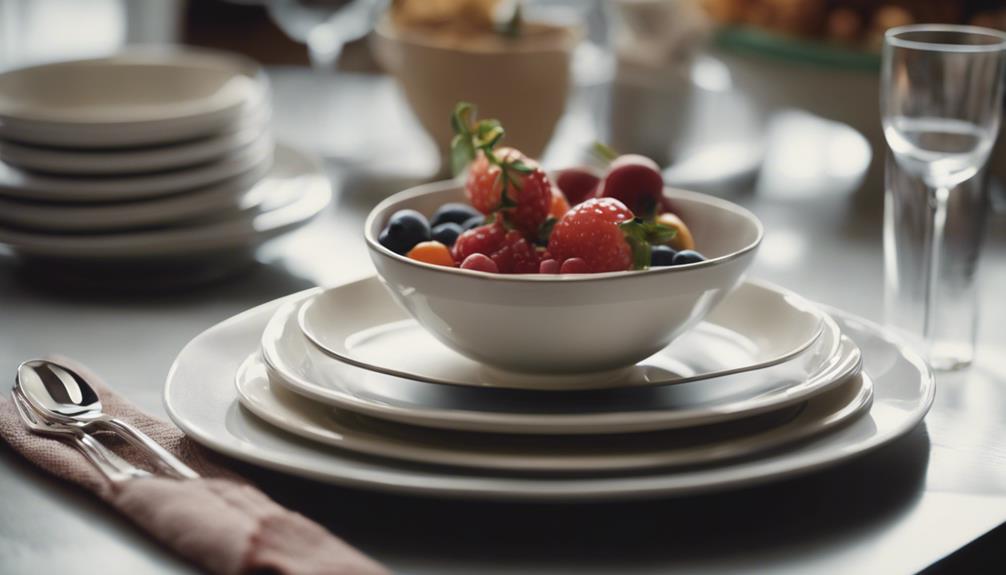
Tableware refers to the utensils, dishware, and serving pieces used for dining and food presentation across cultures. It encompasses various materials, styles, and functions. From ceramic durability to stainless steel strength, tableware offers a wide range of options for different preferences. Historical uses of precious metals like gold highlight its evolution. Plates, bowls, cutlery, and table decorations enhance dining experiences. Western, Chinese, and Japanese table settings showcase distinctive features. Serving dishes and utensils like platters and carving sets make meal service efficient. Tableware continues to adapt with new designs and technologies. Find out more about the intricate world of tableware.
Key Takeaways
- Tableware refers to dishes, utensils, and serving pieces used for dining.
- It encompasses plates, cutlery, glasses, and other items for eating and serving food.
- Tableware includes a variety of materials like ceramic, metal, wood, and disposable options.
- These items are essential for setting a table and presenting food elegantly.
- Tableware enhances dining experiences and can vary in style and purpose.
Definition of Tableware

Tableware encompasses the essential dishes, utensils, and serving pieces required for setting a table and serving food. While kitchen utensils like spatulas and whisks are important for cooking, tableware specifically refers to items used during dining. Plates, glasses, knives, forks, and spoons are common examples of tableware. It's important to note that while kitchen utensils are necessary for food preparation, they don't fall under the category of tableware.
When setting the table for a meal, you'd typically use tableware such as plates for serving food, glasses for beverages, and utensils for eating. These items come in various materials like ceramic, glass, stainless steel, wood, and plastic. While kitchen utensils like measuring cups and cutting boards serve a different purpose, tableware enhances the dining experience. Remember, examples like ladles and tongs are kitchen utensils, not tableware.
Types of Tableware Materials
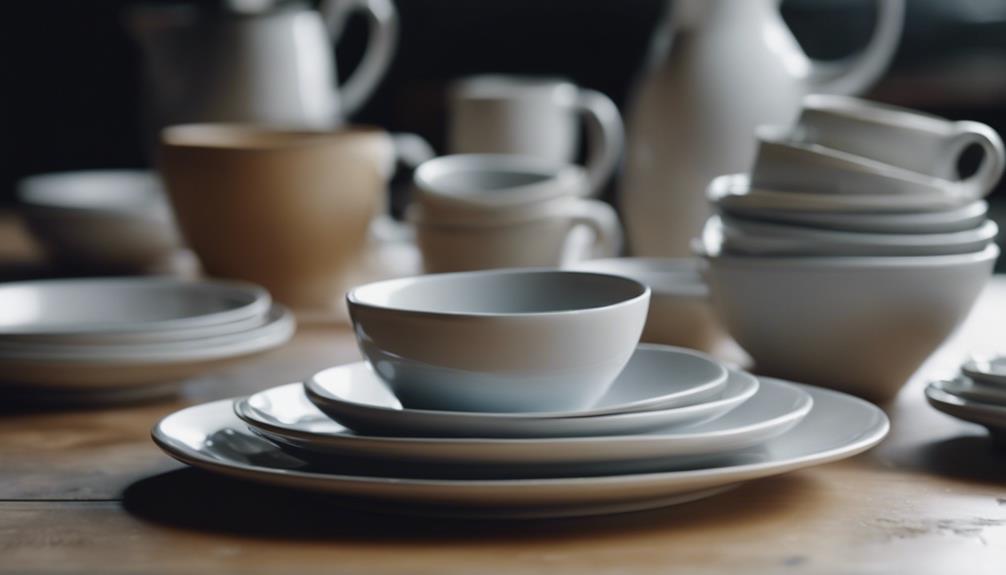
When it comes to tableware materials, various options are available to cater to different preferences and needs.
Ceramic materials like earthenware and porcelain offer durability and aesthetic appeal, while metals like stainless steel are known for their strength and resistance to corrosion.
Wood, glass, acrylic, and melamine are also popular choices, providing a diverse range of options for consumers to choose from.
Common Materials Used
Among the diverse array of materials utilized in tableware production, ceramic materials like earthenware, stoneware, bone china, or porcelain stand out for their durability and aesthetic appeal. Ceramic tableware is a popular choice due to its elegant look and resilience.
Apart from ceramics, materials such as wood, metals like pewter, tempered glass, acrylic, and melamine are also used to suit varied preferences. Stainless steel, known for its strength and corrosion resistance, is commonly used for cutlery in tableware sets.
Additionally, disposable tableware made from paper and plastic is prevalent, particularly with the growing global emphasis on sustainability. These materials cater to different needs and trends in the tableware industry, showcasing the versatility and adaptability of tableware production.
Pros and Cons
Utilizing ceramic materials in tableware offers a blend of durability and aesthetic appeal, making them a popular choice for both everyday use and special occasions. Ceramic tableware, such as earthenware, stoneware, bone china, or porcelain, is known for its elegance and resilience. However, ceramic items may be prone to chipping or breaking if mishandled.
Stainless steel, another common material in tableware, is favored for its strength, resistance to rust, and easy maintenance. On the downside, stainless steel can lack the warmth and charm of ceramic pieces.
Disposable tableware like paper and plastic is convenient but contributes to environmental issues. Other materials like wood, metals, tempered glass, acrylic, and melamine offer a diverse range of options to suit various preferences and requirements.
History of Tableware
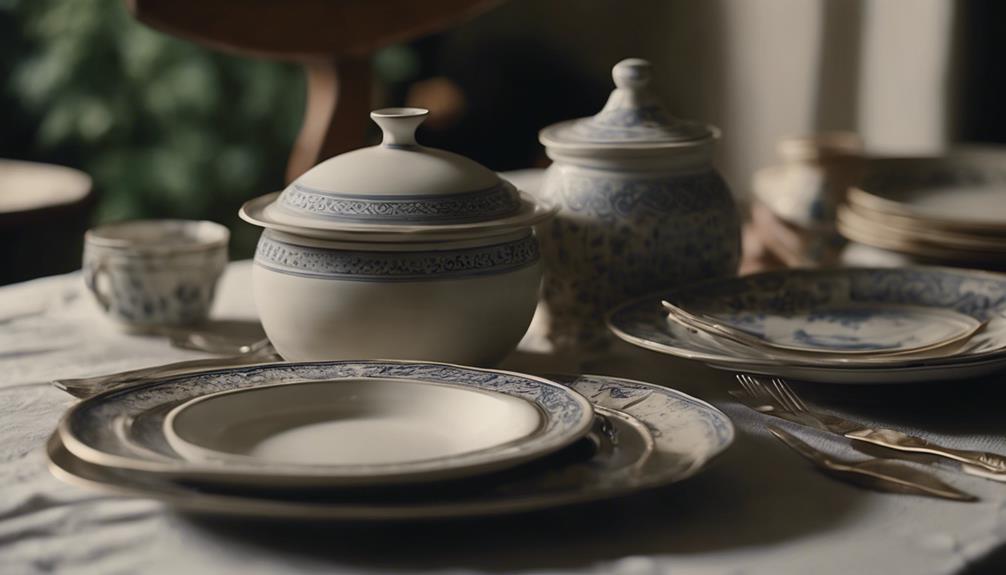
The history of tableware reflects a gradual shift from early pottery to more refined materials like gold and silver.
Trenchers, or bread rounds, were once the norm in medieval dining.
Ownership of elaborate tableware was a status symbol, often regulated by laws to maintain social distinctions.
Evolution of Tableware
During ancient times, the evolution of tableware saw a preference for precious metals like gold and silver among the elite for their flatware. As tableware progressed through history, various materials and styles emerged to meet different needs and preferences:
- Early pottery focused on creating pots and jars rather than flatware for tableware.
- Trenchers, bread rounds used as plates, were common in medieval cuisine as part of tableware.
- Tableware ownership was historically a symbol of wealth and status, regulated by sumptuary laws.
- Plate melting for financial reasons in the Middle Ages led to limited surviving examples of historical tableware.
Cultural Significance
As we explore the historical significance of tableware, it becomes evident that beyond their practical function, these objects carried profound cultural meanings and societal implications.
Early pottery primarily focused on pots and jars, with precious metals like gold and silver being favored by ancient elites for flatware. In medieval times, trenchers, bread rounds used as plates, were common in culinary settings. Owning tableware was a status symbol linked to wealth, often regulated by sumptuary laws.
The financial practice of melting plates resulted in limited surviving examples from the Middle Ages. The evolution of tableware reflects not only changes in dining habits but also the intricate connections between material culture, social hierarchy, and economic dynamics throughout history.
Plates and Vessels in Tableware
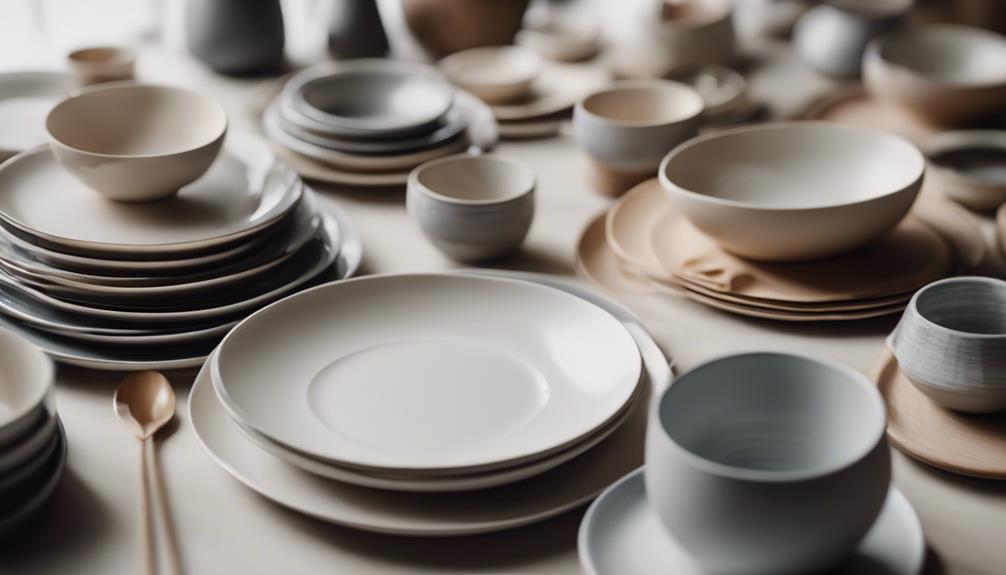
When setting a table, plates and vessels in tableware play a significant role in enhancing the dining experience. Here are five important points to take into account about plates and vessels in tableware:
- Variety: Tableware includes plates, bowls, cups, and other vessels used for serving and eating food, providing a wide range of options for different dining needs.
- Functionality: Plates can vary from dinner plates for main courses to salad plates for appetizers, catering to different serving requirements.
- Design: Vessels in tableware, such as serving bowls for salads or soups and cups for beverages, are designed to not only serve food but also enhance the overall dining experience.
- Presentation: Tableware vessels are crafted to complement the presentation of food, adding aesthetic appeal to the dining table.
- Versatility: The variety of plates and vessels in tableware allows for different styles of dining and serving options, making it versatile for various occasions and preferences.
Cutlery in Tableware

Cutlery in tableware, comprising knives, forks, and spoons, adds a touch of elegance and functionality to your dining experience. These essential utensils are crafted from a variety of materials like stainless steel, silver, or wood. In some regions, cutlery is referred to as silverware or flatware, showcasing cultural naming diversity.
The role of cutlery in table settings is vital, as it not only enhances the dining ambiance but also elevates the overall meal presentation. Depending on the formality of the occasion, the arrangement of cutlery can differ, with formal settings requiring specific placements for each piece.
Whether you're hosting a dinner party or enjoying a meal with your family, the right cutlery can make a significant difference in your dining experience. Choose cutlery that complements your tableware and reflects your personal style to create a memorable dining atmosphere.
Table Decoration Elements

Enhance your dining experience by incorporating enchanting table decoration elements that blend functionality with aesthetics.
- Centerpieces: Elevate your table setting with a striking centerpiece that can range from floral arrangements to decorative sculptures.
- Place Cards: Add a personal touch to your table by using elegant place cards to assign seating for your guests.
- Candles: Create a cozy and inviting atmosphere with the warm glow of candles as part of your table decorations.
- Table Runners: Spruce up your table with a stylish table runner that complements the theme of your dining experience.
- Napkin Rings: Impress your guests by using decorative napkin rings to hold your napkins in elegant folds.
These elements not only enhance the visual appeal of your table but also contribute to the overall ambiance of the dining experience. By carefully selecting and arranging these decoration elements, you can create a memorable and aesthetically pleasing setting for your meals.
Western Style Table Settings

In Western table settings, understanding the distinct styles of service and placement rules for cutlery and dishes is essential for creating an elegant dining experience. Two main styles are service à la russe and service à la française, each with specific guidelines. Service à la russe organizes cutlery based on the number of courses served, with different glasses for water, red wine, and white wine. Traditional Western settings often include serving dishes like butter dishes and casseroles to enhance food presentation. Place markers aid in seating arrangements for a more organized dining experience. Various glasses, plates, and utensils are strategically placed to suit formal, casual, buffet, family-style, and banquet dining occasions.
| Style of Service | Cutlery Placement Rules | Dish Presentation |
|---|---|---|
| Service à la russe | Based on courses served | Butter dishes, casseroles |
| Service à la française | Fixed placement for each course served | Enhances food presentation |
Chinese and Japanese Tableware

Chinese and Japanese tableware showcase distinct cultural aesthetics and materials, offering a unique dining experience compared to Western table settings.
- Chinese tableware often includes chopsticks, bowls, and plates made from materials like porcelain, bamboo, or lacquer.
- Japanese tableware features unique designs like sushi plates, teapots, and sake sets, often crafted from ceramics, porcelain, or wood.
- Chinese table settings may incorporate traditional symbols like dragons, phoenixes, or peonies for cultural significance.
- Japanese table settings reflect a minimalist aesthetic with clean lines and natural materials like wood and stoneware.
- Both Chinese and Japanese tableware emphasize the harmony of design elements, such as color, shape, and texture, to enhance the dining experience.
These tableware traditions not only serve practical purposes but also embody centuries-old cultural values, making each dining experience a blend of functionality and artistry.
Whether enjoying a meal with friends or family, the intricate details and thoughtful designs of Chinese and Japanese tableware can elevate the dining experience to a new level of appreciation for craftsmanship and culture.
Serving Dishes and Utensils

Serving dishes and utensils come in various types, serving different purposes during meals.
From platters for showcasing main dishes to ladles and tongs for serving, each utensil plays a specific role.
Understanding the uses of these items can enhance your dining experience and make serving food more efficient.
Types of Utensils
Enhance your table setting and dining experience with a variety of essential utensils like serving spoons, ladles, tongs, and carving sets in tableware setups. These utensils play an important role in presenting and serving food efficiently.
Here are some common types of utensils used in serving dishes and setups:
- Platters: Ideal for serving main dishes or appetizers.
- Serving Bowls: Perfect for salads, side dishes, or soups.
- Gravy Boats: Essential for pouring gravies and sauces.
- Casseroles: Great for baking and serving hot dishes.
- Carving Sets: Useful for slicing and serving meats or large roasts.
These utensils are designed to make serving food easier and more elegant, enhancing the overall dining experience.
Uses of Serving Dishes
With the right serving dishes and utensils, you can effortlessly elevate the presentation of your dishes and enhance the dining experience. Serving dishes are essential for presenting food elegantly, coming in various shapes, sizes, and materials like ceramic or glass. They add sophistication and visual appeal to meals, perfect for buffet-style dining, family gatherings, formal dinners, and special occasions.
These dishes play an important role in complementing the overall table setting and enhancing the dishes being served. Choosing the right serving dishes can make a significant difference in how your meals are perceived and enjoyed. Invest in quality serving dishes to create a memorable dining experience for you and your guests.
Tableware Adaptations

Tableware adaptations have revolutionized the traditional dining experience by incorporating cutting-edge technologies and sustainable practices. These advancements have brought about significant changes in the way we perceive and interact with tableware. Here are some key points to ponder:
- Industrial Applications: Tableware materials are now being repurposed for industrial uses, such as using ceramic printers to create innovative designs.
- Active and Aware Designs: New tableware designs are being developed to be active and aware objects, capable of responding to their environment.
- Eco-Friendly Practices: Biofuel production has introduced innovative ways to utilize tableware materials, promoting sustainability.
- Advanced Technology Integration: Tableware now features advanced technology, transforming them into functional and interactive pieces.
- Aesthetic and Functional Designs: Repurposing tableware materials has led to the creation of designs that blend aesthetics with functionality, meeting modern needs and preferences.
These adaptations showcase the versatility and potential of tableware beyond its traditional role, paving the way for a more dynamic dining experience.
Frequently Asked Questions
What Is Considered Tableware?
Tableware encompasses plates, glasses, knives, forks, and spoons for dining. Materials like ceramic, glass, stainless steel, wood, and plastic are commonly used. Table settings range from formal to casual, buffet to family-style.
Major brands include Wedgwood, Royal Doulton, Mikasa, Lenox, and Villeroy & Boch. Trends focus on minimalist designs, sustainable materials, mix-and-match styles, bold colors, and vintage-inspired pieces. These items enhance your dining experience and add style to your table setting.
What Are the Basic Types of Tableware?
When setting the table, you'll need essential tableware like plates, glasses, knives, forks, and spoons. These items serve both practical and aesthetic purposes, allowing you to enjoy meals with ease and style.
Materials such as ceramic, glass, stainless steel, wood, and plastic offer various options to suit your preferences. From formal to casual settings, tableware plays a vital role in enhancing your dining experience and presentation.
What's Another Word for Tableware?
When thinking about tableware, you might wonder, 'What's another word for tableware?'
Synonyms for tableware include dinnerware, dishes, crockery, and serveware. These terms encompass the plates, glasses, cutlery, and serving dishes used during dining.
Understanding these synonyms can help clarify the meaning of tableware in various dining and hospitality contexts. So, next time you set the table, remember these alternative names for your essential dining items.
What Is a Fancy Word for Plates and Bowls?
When it comes to fancy table settings, plates and bowls are often referred to as 'tableware.' This term covers all the items used for serving and enjoying your meals, from cups and saucers to serving dishes and utensils like knives, forks, and spoons.
Tableware can be crafted from various materials like ceramic, glass, stainless steel, wood, or plastic, adding a touch of elegance to your dining experience.
Conclusion
To sum up, tableware encompasses a wide range of items used for dining and serving food. From plates and cutlery to serving dishes and utensils, tableware plays an essential role in mealtime rituals around the world.
Whether you prefer Western style table settings or Chinese and Japanese traditions, the appropriate tableware can enhance your dining experience. As the saying goes, 'The table is a meeting place, a gathering ground, the source of sustenance and nourishment.'
Choose your tableware wisely and enjoy your meals in style.
Tableware and Dining Accessories
When Is Tableware on Sale at Hobby Lobby
Pounce on incredible discounts for tableware at Hobby Lobby with alternating weekly sales, starting with a 50% discount – find out more!
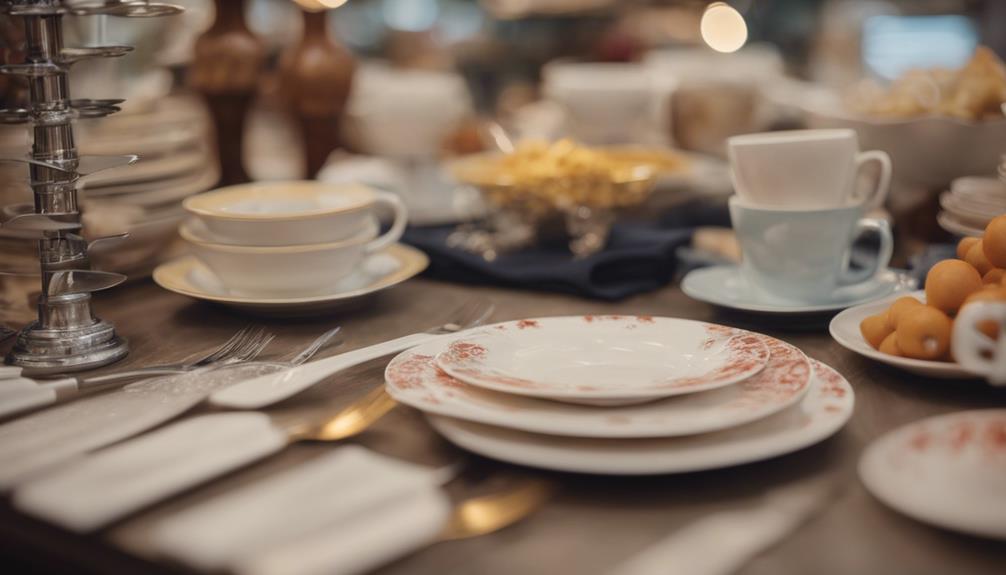
Tableware at Hobby Lobby goes on sale every other week, alternating with wall decor, offering a 50% discount. You can also enjoy biweekly 40% discounts on paper napkins, plates, wedding supplies, and cake decorating items. The discounts extend to gift wrap, bags, floral table decor, and various crafting supplies to help you save consistently. Special wedding sales events in September provide up to 50% off on tableware. Stay updated on Hobby Lobby's weekly ad for precise sale details and make the most of these savings for your home or special events. Learn more about the sale patterns for various tableware items.
Key Takeaways
- Tableware goes on sale every other week at Hobby Lobby.
- Alternates with wall decor at a 50% discount.
- Additional discounts during seasonal events and holidays.
- Biweekly 40% discount on paper napkins, plates, and wedding supplies.
- Check weekly ad for precise sale schedule and discounts.
Regular Sale Schedule for Tableware

If you're wondering about the routine discounts on tableware at Hobby Lobby, the regular sale schedule is here to guide your shopping strategy.
Tableware goes on sale every other week at Hobby Lobby, alternating with wall decor at a 50% discount. This means you can plan your visits to catch the best deals on items like paper napkins, plates, and cake decorating supplies.
Specifically, paper napkins and plates are always discounted, making it a great time to stock up on these essentials. Additionally, cake decorating items, which are also part of tableware, are discounted by 40% biweekly, providing savings for baking enthusiasts.
It's worth noting that during seasonal events and holidays, tableware items like paper plates, napkins, and cake decorating supplies may receive additional discounts. To stay updated on these offers, make sure to keep an eye on the weekly ad and sale schedule to plan your purchases accordingly.
Paper Napkins and Plates Discount

Paper napkins and plates at Hobby Lobby always come with discounted prices, making them essential items to stock up on during your shopping trips. Here are some key details about the discounts on these party items:
- Biweekly Discounts:
Hobby Lobby offers a biweekly 40% discount on paper napkins and plates, allowing you to save on your regular party supplies.
- Wedding Supplies Special:
If you're planning a wedding or a special event, take advantage of the 40% off biweekly discount on wedding supplies, with an even better 50% discount available in September.
- Regular Savings:
Whether you're hosting a party, celebrating a special occasion, or just need paper napkins and plates for everyday use, Hobby Lobby's weekly discounts ensure you can always enjoy savings on these essential items.
With these ongoing discounts, you can always be prepared for any gathering without breaking the bank.
Gift Wrap and Bags Sale Frequency

Gift wrap and bags at Hobby Lobby are consistently discounted every other week, allowing customers to save 50% on these essential items. The biweekly rotation of sales on gift wrap, gift bags, paper napkins, plates, and other party supplies enables shoppers to plan their purchases strategically and enjoy regular discounts. This predictable sale frequency guarantees that you can always find these items at a great price, making it easier to stock up on your party essentials without breaking the bank. Take advantage of Hobby Lobby's discounts on party supplies during these biweekly sales to save money while preparing for your next celebration.
| Sale Frequency | Discount |
|---|---|
| Every other week | 50% off |
| Biweekly rotation | Save consistently |
| Regular discounts | Budget-friendly shopping |
Cake Decorating Items Discount Pattern

Cake decorating items at Hobby Lobby follow a biweekly discount pattern, with specific tools and supplies going on sale every two weeks. This allows you to plan your purchases and take advantage of the 40% off savings on baking essentials.
Keep an eye out for wedding supplies related to cake decorating, as they offer 40% off every other week and 50% off in September.
Cake Tools Sale Dates
During the biweekly sales at Hobby Lobby, cake decorating enthusiasts can save 40% on essential tools like cake pans, decorating tips, pastry bags, and fondant tools. Make sure to mark your calendars and take advantage of these discounts to stock up on your favorite cake tools.
Here's what you need to know:
- Cake Pans
- Decorating Tips
- Pastry Bags
Discounted Baking Supplies
When shopping for discounted baking supplies at Hobby Lobby, keep an eye out for the regular 40% off sales on cake decorating items to save on essential tools like cake pans, decorating tips, and pastry bags.
Hobby Lobby offers biweekly discounts on cake decorating items, making it convenient for customers to grab what they need for their baking projects at a lower price.
In addition to cake tools, paper napkins and plates are always on sale, providing an opportunity to stock up on party supplies without breaking the bank.
With a diverse sale schedule that includes various party supplies, Hobby Lobby guarantees that customers can find discounts on tableware items throughout the year.
Make the most of these deals to enhance your baking and party-planning experience.
Discounts on Floral Table Decor

Keep an eye out for frequent discounts on floral table decor items at Hobby Lobby, including stems, bushes, arrangements, garland, and wreaths, as they're typically featured every other week.
Key Points to Note:
- Variety of Items: Hobby Lobby offers a range of floral table decor items on sale, such as stems, bushes, arrangements, garland, and wreaths.
- Regular Discounts: These floral table decor items are discounted regularly, making it convenient for you to find deals on a variety of pieces.
- Seasonal Promotions: While the sale schedule for floral table decor may vary, keep an eye out for special discounts during seasonal promotional periods.
When browsing for floral table decor at Hobby Lobby, take advantage of these discounts to elevate your table settings with beautiful and affordable pieces.
Whether you're looking to refresh your home decor or prepare for a special event, these sales provide an opportunity to enhance your space without breaking the bank.
Sale Timing for Party Supplies
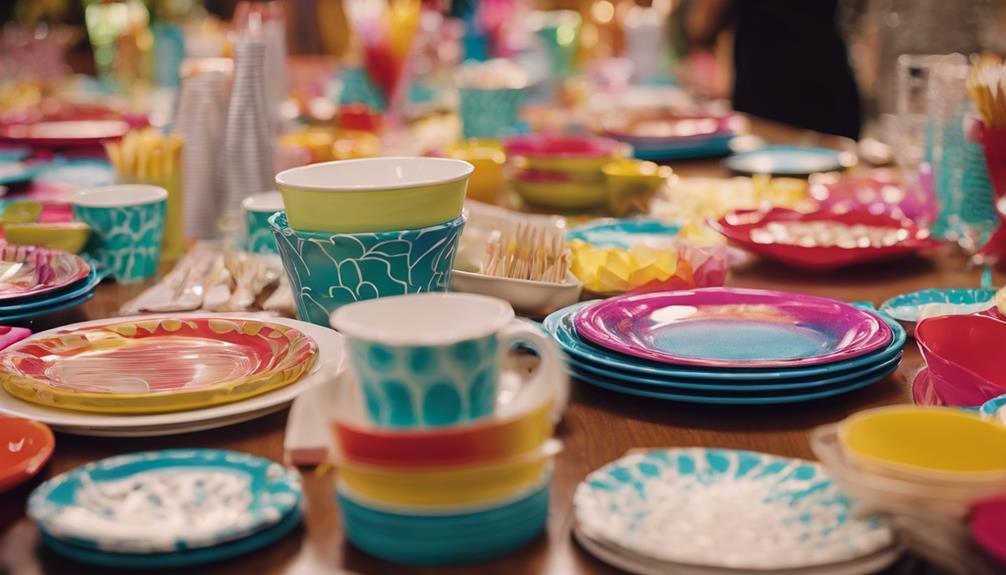
When it comes to shopping for party supplies at Hobby Lobby, timing is key.
Keep an eye out for biweekly discounts on cake decorating items, wedding supplies, and even tableware.
Timing for Party Sales
Party supplies at Hobby Lobby are regularly discounted, with specific items like tableware, paper napkins, and plates often being on sale. If you're planning a party and looking to save some money, here's when you can expect party sales at Hobby Lobby:
- Cake decorating items go on sale every two weeks.
- Gift wrap and gift bags are half price every other week.
- Wedding supplies are discounted every other week and are 50% off in September.
Don't forget to check the weekly ad for specific details on party items sales at Hobby Lobby. Keep an eye out for special promotions to make your party planning more budget-friendly!
Discounted Party Supplies
Discounted offerings on party supplies at Hobby Lobby include paper napkins, plates, gift wrap, and bags. These items are regularly featured at discounted prices. Cake decorating items are also discounted by 40% on a biweekly basis. For those planning a wedding, wedding supplies are available at a 40% discount every other week and at a 50% discount in September. Additionally, weekly discounts on various party items are offered throughout the year. Keep an eye out for these sales to save on your party planning needs.
Visit Hobby Lobby frequently to catch these fantastic deals on tableware and other party supplies.
Seasonal Markdowns for Tableware
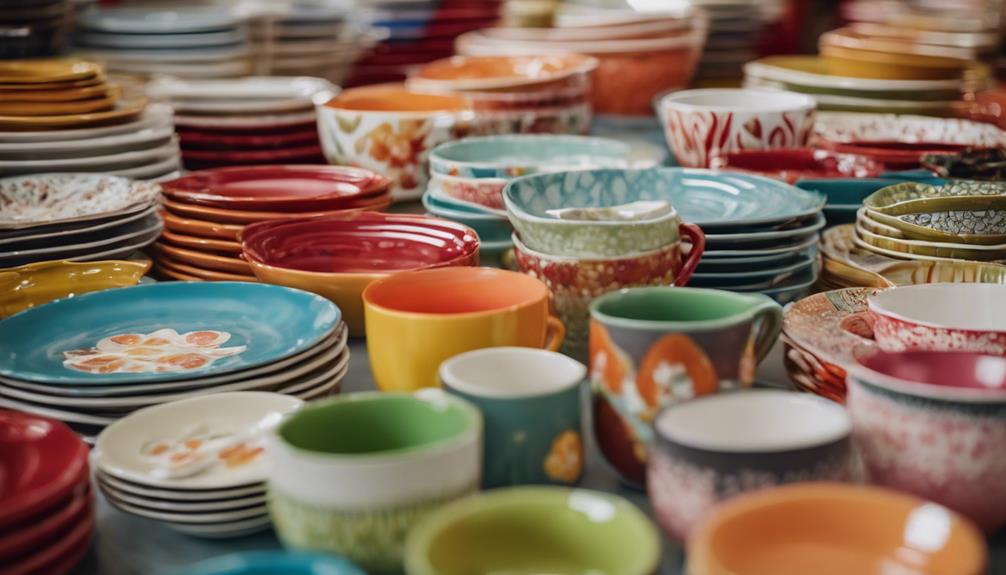
Are you curious about the seasonal markdowns for tableware at Hobby Lobby? Here's what you need to know:
- After-Holiday Sales: Tableware at Hobby Lobby often goes on sale during seasonal markdowns following major holidays like Thanksgiving and Christmas.
- Discounted Items: Look out for discounts on a variety of tableware items such as plates, napkins, cups, and tablecloths during clearance events at Hobby Lobby.
- Significant Savings: Seasonal markdowns on tableware can offer discounts of up to 50% off or more, allowing for substantial savings for shoppers.
Don't forget to check the Weekly Ad or Hobby Lobby's website for specific dates when tableware will be on sale. Keep an eye out for special promotions or themed sales that may include further discounts on tableware items. Take advantage of these seasonal markdowns to update your tableware collection while saving money at Hobby Lobby.
Special Discounts on Wedding Items

Get ready to save big on wedding items at Hobby Lobby with special discounts on tableware and more.
Hobby Lobby offers discounts on wedding tableware every other week, with savings of up to 40% off. Additionally, keep an eye out for special wedding sales events in September where tableware discounts can go as high as 50% off.
These biweekly discounts on various wedding supplies, including tableware, aim to help couples save on their special day. For those preparing for a wedding reception, cake decorating items and tableware accessories are discounted by 40% every other week.
Crafting Supplies Sale Cycle
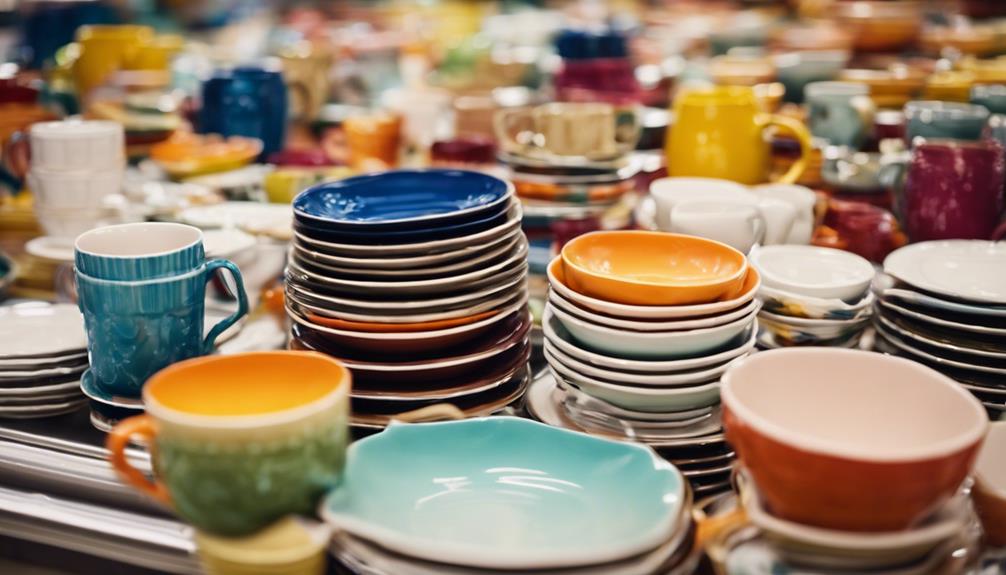
Crafting enthusiasts can take advantage of Hobby Lobby's regular sale cycle for crafting supplies. Here's what to expect:
- Party Supplies: Tableware items, including paper napkins and plates, are part of the Party Supplies department sales rotation, offering discounts to shoppers.
- Biweekly Savings: Keep an eye out for items like gift wrap and bags, which are discounted every other week. This means you can find these products at half price during specific periods.
- Cake Decorating Deals: If you're into cake decorating or in need of tableware for special occasions, you're in luck. Cake decorating items go on sale at 40% off on a biweekly basis, providing great savings for your crafting projects.
Remember to check the weekly ad for precise details on when tableware items, along with other crafting supplies, will be on sale at Hobby Lobby. Stay informed to make the most of these discounts!
Frequently Asked Questions
What Day of the Week Does Hobby Lobby Change Their Sales?
Hobby Lobby changes their sales every Sunday, releasing a new weekly ad. This is when you can find out about discounts on tableware or other items. Keep an eye on the ad for specifics.
Table decor, including tableware, might be 50% off every other week. To stay updated on sales, follow Hobby Lobby's calendar.
How Do I Know if Something Is on Sale at Hobby Lobby?
To know if something's on sale at Hobby Lobby, simply check their weekly ads! These ads, released every Sunday, will clue you in on all the sweet deals, including those on tableware.
Keep an eye out for those 50% off Home Decor sales, where tableware often pops up. You can also sign up for email updates or browse their website for the latest info on Hobby Lobby's sales.
Stay savvy and snag those discounts!
Does Hobby Lobby Have the Same Sales Online and In-Store?
Hobby Lobby offers the same sales online and in-store, ensuring you get consistent discounts on tableware no matter where you shop.
You can enjoy synchronized savings on tableware, with prices matching between their website and brick-and-mortar locations.
Whether you prefer to shop from the comfort of your home or in person, Hobby Lobby has you covered with the same great deals on tableware.
Does Hobby Lobby Do Price Adjustments?
Hobby Lobby doesn't offer price adjustments after purchase. Once you buy something, the price is set and can't be changed later. This policy applies to discounted or sale items, so it's important to shop smart and snag deals when they're available.
Remember to look for the best prices to save money, as Hobby Lobby doesn't allow retroactive price changes. Make sure to make informed purchases to get the most out of your shopping experience.
Conclusion
So next time you're in need of some tableware, make sure to keep an eye out for the regular sales at Hobby Lobby.
With discounts on paper napkins, gift wrap, cake decorating items, floral table decor, party supplies, and even seasonal markdowns, you'll be sure to find everything you need at a great price.
And don't forget about the special discounts on wedding items and crafting supplies too! Happy shopping!
-

 Vetted1 month ago
Vetted1 month ago14 Best Personalized Father's Day Gifts for Your Husband – Show Him You Care
-

 Alfresco1 month ago
Alfresco1 month agoAlfresco Stacker Doors: Seamless Indoor-Outdoor Living!
-

 Craft and Textiles3 months ago
Craft and Textiles3 months ago15 Best Places to Buy Appliances for Your Home – Top Retailers Reviewed
-

 Decorative Throws3 months ago
Decorative Throws3 months agoIs It Better to Dry Clean Blankets?
-

 Tableware and Dining Accessories3 months ago
Tableware and Dining Accessories3 months agoWhat Is the Hindi Meaning of Tableware
-

 Tableware and Dining Accessories3 months ago
Tableware and Dining Accessories3 months agoWhat Is the Meaning of the Word Tableware
-

 Craft and Textiles3 months ago
Craft and Textiles3 months ago15 Best Cordless Mowers for Effortless Lawn Care – Top Picks of 2024
-

 Yarn3 months ago
Yarn3 months agoIs Yarn Natural or Manmade? Unravel the Truth






















